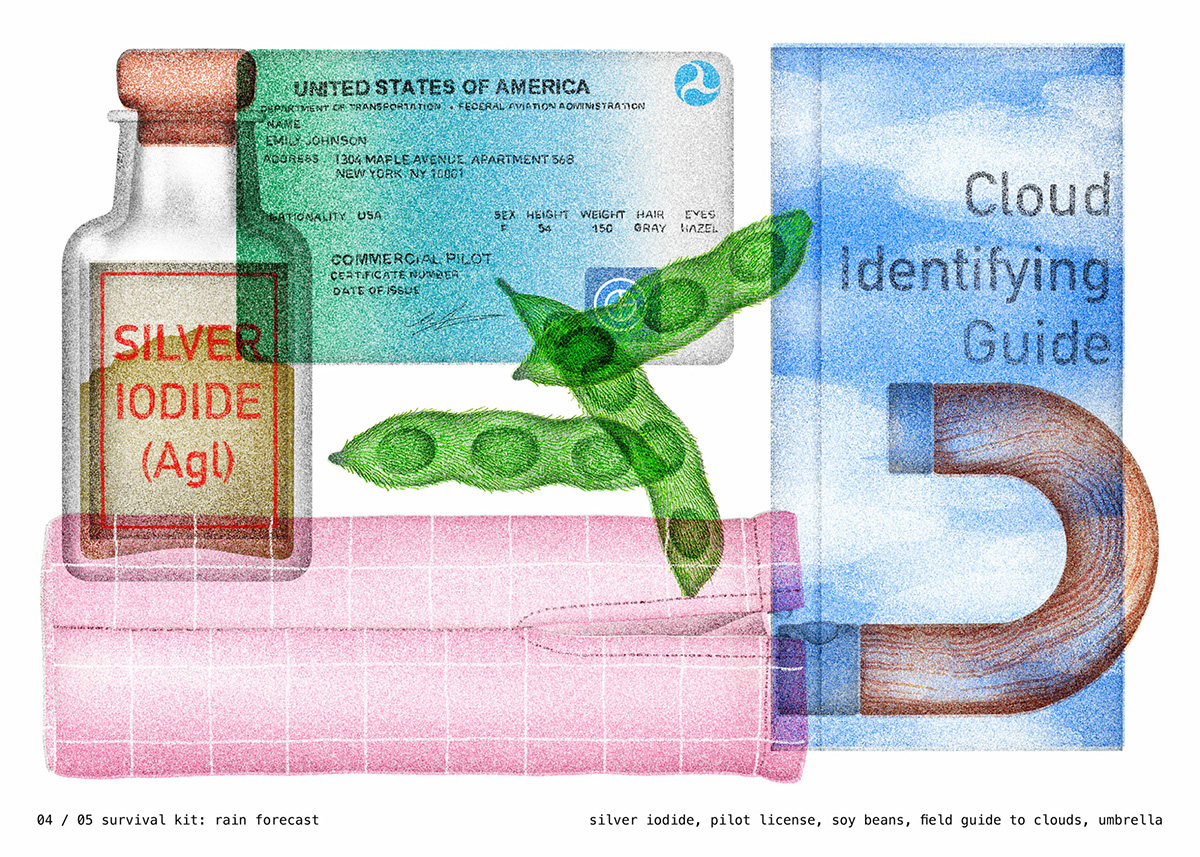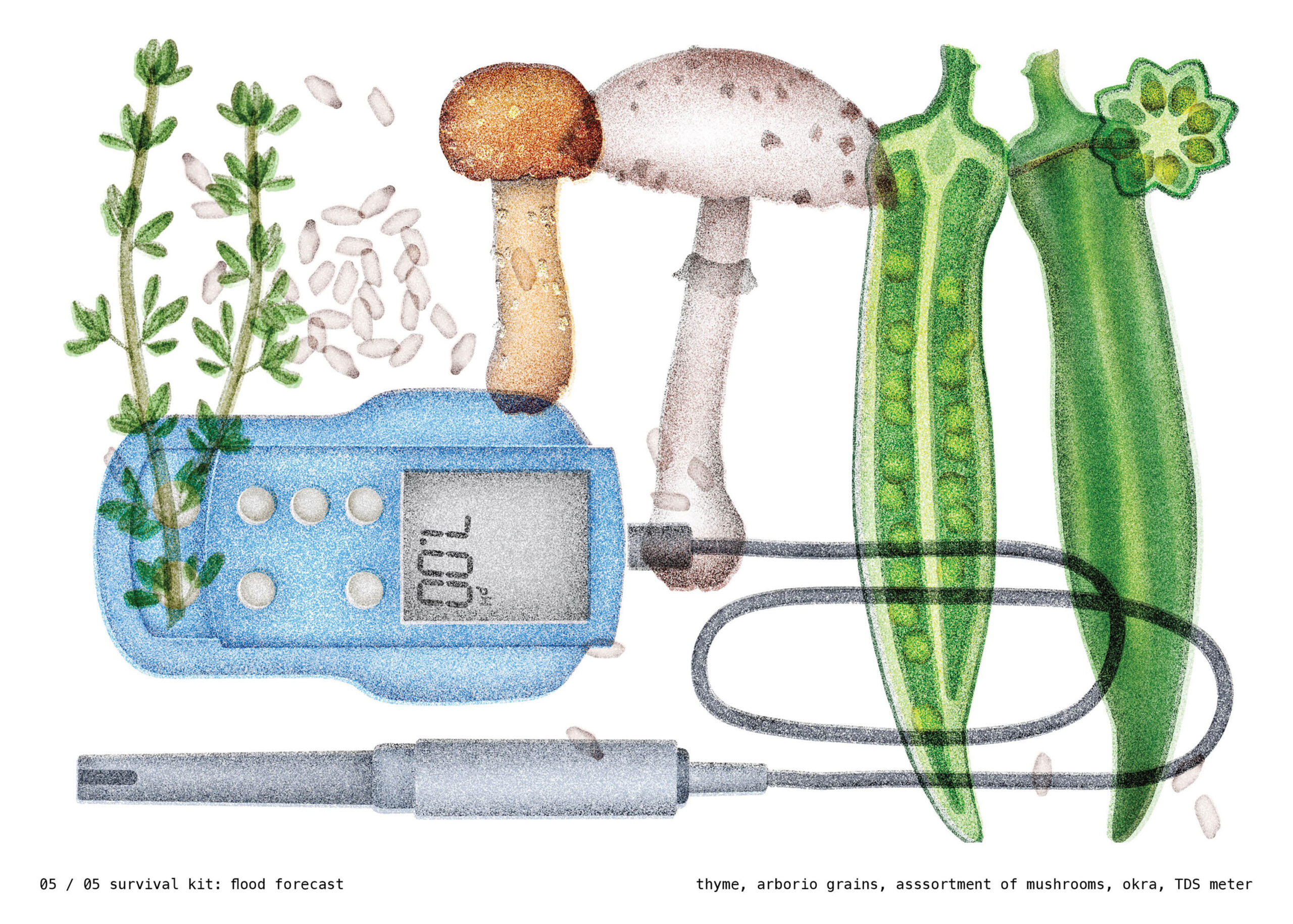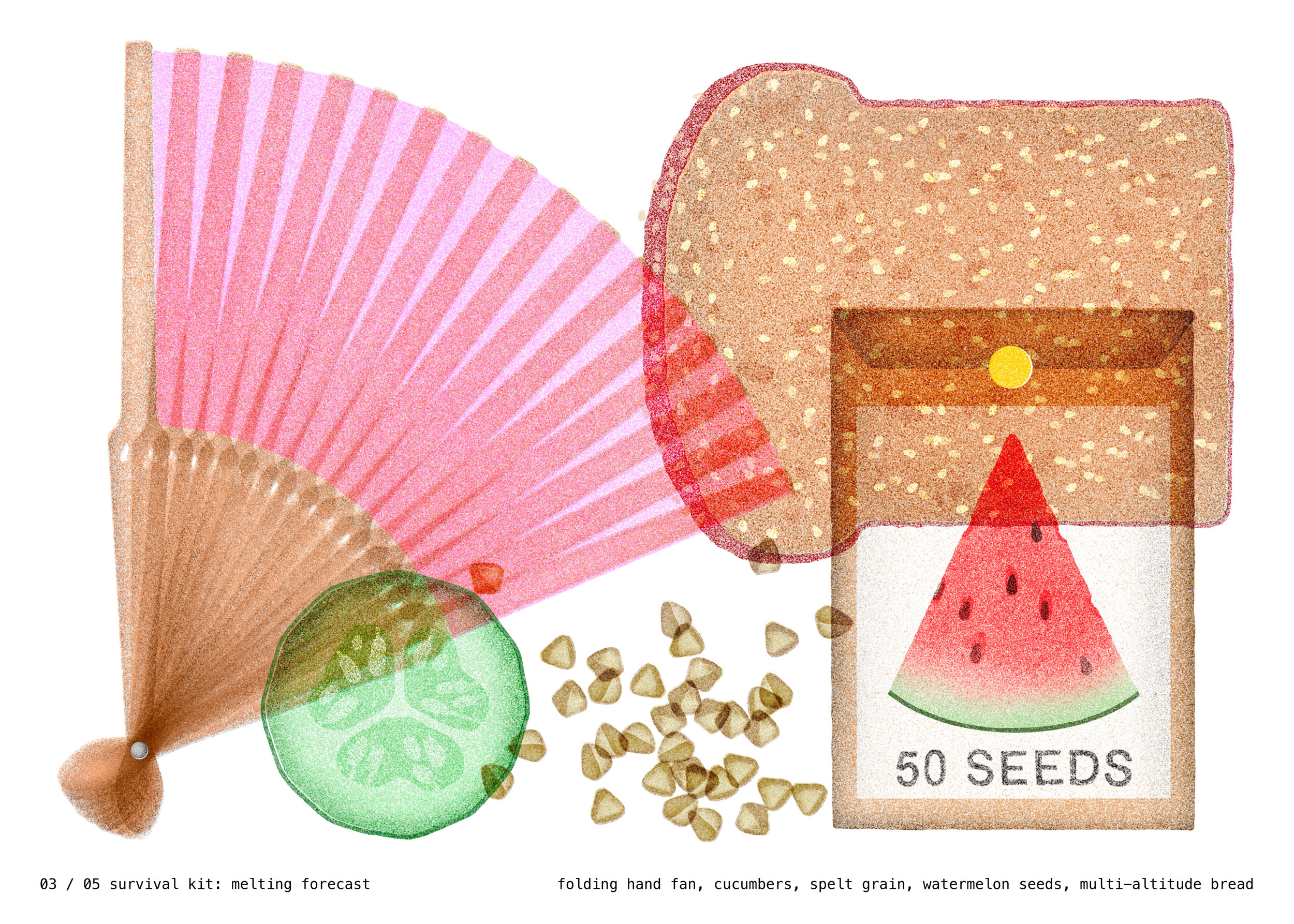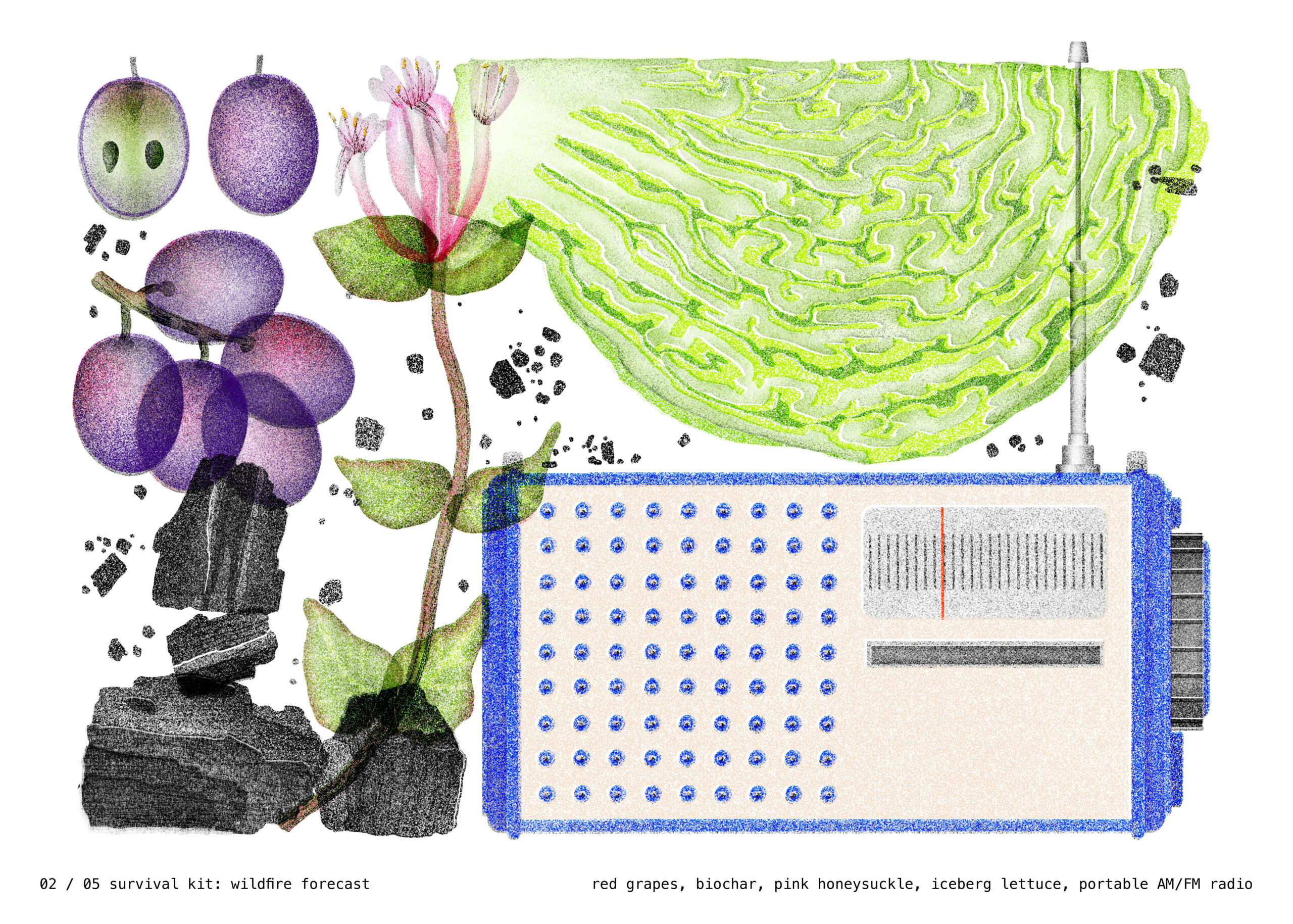Whether it is the elaborate rainmaking rituals of the Luo in Kenya, the Japanese Ayako Odori rain dance, or the 16-day Hopi Snake Dance and prayer for rain, humans have always sought to control the weather. Most recently, scientists have employed technology in a process called cloud seeding to manipulate weather patterns. A few years ago in France’s Burgundy wine region, farmers invested in a cloud seeding program to diffuse hail that was severely ruining crops. Vineyards have a history of attempted weather modification, traditionally using giant hail cannons that look like massive skyward trumpets to create reverberations that would break up the hail. Using radar systems, they released silver iodide into the clouds to turn would-be hail into rain, in a sense, turning water into wine. In this instance, farmers imagined a future in which weather modification might be used as a tool of agriculture. Clouds are floating islands of valuable, free freshwater that for the most part evade human control. They are notoriously difficult to model, defying borders, and constantly shifting form. To truly control these bodies of water or any climate conditions would be an unimaginable power with consequences beyond our capacity to predict through data alone.
My first encounter with weather modification was in Beijing ahead of the 2008 Olympics. That summer I watched smoggy clouds break open to produce giant, juicy rainstorms which would be followed by days of uncharacteristic blue sky and sun. This happened every week like clockwork. People started to casually use the term “cloud seeding” in conversations to explain how the Chinese government was shooting chemicals into the clouds to induce rain to ensure a smog and rain-free opening ceremony. Like some sort of sorcery, they were allegedly controlling the skies. It initially seemed to me to be a paranoid and surreal theory but, the “Beijing Weather Modification Office (北京市人工影响天气办公室)” was investing millions into shooting silver iodide, a type of salt, into the clouds to make it rain. This was part of a broader “blue-skying” initiative, which is still in use today. Once injected, the water particles that make up clouds essentially become heavy, which leads to rainfall. Since its invention in the 1950s, cloud seeding has been applied with a variety of intentions including reducing air pollution, boosting morale, increasing rainfall for agriculture, fire suppression, and reducing hail damage on crops.
Cloud seeding was my gateway into learning about the larger field of geoengineering, a range of technologies being developed to mitigate the effects of climate change through deliberate planetary-scale interventions into our climate systems. These technologies scare me in a deep way. Design at the scale of the planet is risky, contentious, and beyond ideal, but given the pressures of climate change and lack of swift action, they are increasingly critical to consider. Debates around geoengineering technologies haven’t changed much in the past decade. They usually center on the unknown implications of meddling at a planetary scale, the “moral hazard” of disincentivizing cuts to emissions and other climate measures in favor of a fix-all technology, and the issue of regulations and benefits. Many of these concerns stay at a theoretical level even though there are concrete examples of geoengineering being applied. This isn’t some far off future. This is now. Forcing rain has become akin to squeezing lemons.
While studies investigating the efficacy of this technology show conflicting results, in the past few months, you might have seen the widely circulated videos citing cloud seeding as the cause of massive floods in the UAE. (While the UAE does use cloud seeding programs to increase their groundwater, these floods were largely considered unrelated.) For many, this was the first time they had heard about cloud seeding but attempts to manage weather are far-reaching and have been in development for decades. From the Colorado River Basin in the United States to, to the desert of the UAE, governments and billionaires such as Jeff Bezos and Bill Gates are investing in the development of geoengineering technologies like cloud seeding.

Cloud seeding has been contentious and hotly debated since its inception. There is a TIME magazine article from 1962 titled “Agriculture: The Battle of the Clouds” about “disgruntled farmers” who rebel against cloud seeding programs in the Appalachian region. The article outlines how conditions escalated to the point that “Farmers have threatened to shoot at cloud-seeding planes. In Mercersburg, they were blamed for cutting down 138 plum trees belonging to Orchardist Henry Heisey” who “decided to withdraw from the Weather Modification Association.” Despite this backlash and skepticism, six decades later cloud seeding programs are running in over 10 states across the United States, usually run by Water Conservation departments to manage water levels and agricultural output.
I spoke with Darin Langerud, Division Director of Atmospheric Resources in North Dakota who oversees and enacts the weather modification programs across the state. In North Dakota, the basis of their program is designed to enhance growing season precipitation for cropland where wheat, durum, barley, and soybeans are grown as well as to reduce the losses from hail damage. He explained that counties will opt into the program, an initiative usually spearheaded by local farming and ranching communities. The state will then sets them up with companies that will provide aircraft, radar services, and seeding technology. They train these interdisciplinary teams on how to determine the ideal clouds to seed and how to fly planes that inject and shoot flares of silver iodide into those clouds.
Langerud cited studies that his team had initiated, showing about a 10% increase in precipitation, a large enough percentage to make it worth it, yet still a small enough percentage for it to seem non-threatening. “As we continue to improve the technology, I think it will likely continue to grow and expand,” he predicts. Langerud clarified that improvement means increasing the efficacy of cloud seeding at inducing rainfall. The technology is far from being able to tap water directly from clouds but the higher the percentage of increased participation, the larger the positive impact for the farmers and resulting interference into pre-existing water cycles. One of the most common critiques of this industry is the unknown externalities of forcing rain. Could you potentially steal clouds from other states or countries? If it is truly effective, there is a possible future in which cloud seeding could be as ubiquitous of an agricultural tool as a tractor or as functional as an automated irrigation system. However if applied at scale, there surely will be unimaginable ecological and social consequences.


In the realm of geoengineering there are interventions being proposed that are far more drastic, expensive, and require much more coordination to enact than cloud seeding. Two of the main categories are solar geoengineering which is a means of brightening clouds by injecting them with sulfur dioxide so that they reflect sunlight out of the earth’s atmosphere to lower global temperatures and carbon dioxide removal (CDR) an energy-intensive process thatremoves CO2 out of the atmosphere.
We are entering an era where regulation has not caught up with the application of these technologies. Last June, the US Office of Science and Technology Policy (OSTP), with support from the National Oceanic and Atmospheric Administration (NOAA) published a report and a preliminary plan for how to regulate solar geoengineering. While solar geoengineering has yet to be implemented, the first direct carbon capture plant in the United States just opened last year. Adoption of this technology has been accelerated in part because it fits neatly into an existing economic agenda where major companies can buy carbon capture credits to offset emissions. The immediate risks are lower than with solar engineering. However, in a conversation with Josh Horton, Research Director of Geoengineering at Harvard, he emphasizes that for carbon capture to be effective it would require an industry as large as the oil industry itself.
Horton strongly advocates for a moratorium on the application of geoengineering in favor of doing more research. He is an ethical and cautionary voice in a geoengineering world that is looking for big fixes to massive climate dysregulation, “You’ve got to remind yourself, be humble. Which doesn’t mean don’t do anything,” he tells me, “But if you’re going to do it, do it with caution, and in full awareness of what you’re taking on. And in a spirit of openness and listening, not just hearing, but listening to other people’s concerns.”
The less we do about curbing our impact on climate change now, the more desperate and outlandish the suggestions will become. Harvard’s Solar Geoengineering Research Program studies what is perhaps the most contentious category of geoengineering because the risks of getting it wrong are so high. Unfortunately, it is one of a few strategies that could actually contend with the past century of temperature rise.
“People tend to say, well, we don’t want to do geoengineering… compared to what the world was yesterday or what it used to be. But that’s not the proper comparison. It’s what the world is likely to be anyway, without doing it,” he continues, “Things are getting bad. So you have to at some point sort of compare risks to risks.” If we do ever employ this technology at scale, Horton emphasized “it’s gonna be a tragic choice”
Right now, the best choice is to curb emissions and hope that we can lower global temperatures enough that they do not result in extreme ecological meltdown. If we cannot halt global emissions, then temperatures will rise and drought will continue to spread. High heat and low water will be the death knell of most agriculture, and with it, the communities it supports. Historians often credit the decline of key ancient civilizations, such as the Mayans, with sustained drought, and specific geopolitical conflicts and wars can be linked to a lack of rainfall on cropland. If the choice becomes between our survival as a species and the increased application of geoengineering technologies, what would you want to ensure was built into these systems that are in development today?
Below is a recipe for rain:
Silver Iodide (Agl)
Flares
Airplane
Moisture-rich clouds
- Wait until the formation or presence of moisture-rich clouds.
- Outfit an airplane with flares and silver iodide
- Fly below the clouds and release flares which burn and initiate silver iodide into the inflow of the clouds.
- Wait for rain.




